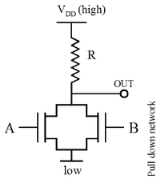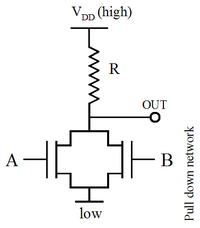
NMOS logic
Encyclopedia
N-type metal-oxide-semiconductor logic uses n-type
metal-oxide-semiconductor field effect transistors (MOSFET
s) to implement logic gate
s and other digital circuit
s. NMOS transistors have four modes of operation: cut-off (or sub-threshold), triode, saturation (sometimes called active), and velocity saturation.
The n-type MOSFETs are arranged in a so-called "pull-down network" (PDN) between the logic gate output and negative supply voltage, while a resistor is placed between the logic gate output and the positive supply voltage. The circuit is designed such that if the desired output is low, then the PDN will be active, creating a current path between the negative supply and the output.
 As an example, here is a NOR
As an example, here is a NOR
gate in NMOS logic. If either input A or input B is high (logic 1, = True), the respective MOS transistor acts as a very low resistance between the output and the negative supply, forcing the output to be low (logic 0, = False). When both A and B are high, both transistors are conductive, creating an even lower resistance path to ground. The only case where the output is high is when both transistors are off, which occurs only when both A and B are low, thus satisfying the truth table of a NOR gate:
A MOSFET can be made to operate as a resistor, so the whole circuit can be made with n-channel MOSFETs only. For many years, this made NMOS circuits much faster than comparable PMOS and CMOS circuits, which had to use much slower p-channel transistors. It was also easier to manufacture NMOS than CMOS, as the latter has to implement p-channel transistors in special n-wells on the p-substrate. The major problem with NMOS (and most other logic families
) is that a DC current must flow through a logic gate even when the output is in a steady state
(low in the case of NMOS). This means static power dissipation, i.e. power drain even when the circuit is not switching. This is a similar situation to the modern high speed, high density CMOS circuits (microprocessors etc.) which also has significant static current draw, although this is due to leakage, not bias. However, older and/or slower static CMOS circuits used for ASIC
s, SRAM
etc., typically have very low static power consumption.
Also, NMOS circuits are slow to transition from low to high. When transitioning from high to low, the transistors provide low resistance, and the capacitative charge at the output drains away very quickly (similar to discharging a capacitor through a very low resistor). But the resistance between the output and the positive supply rail is much greater, so the low to high transition takes longer (similar to charging a capacitor through a high value resistor). Using a resistor of lower value will speed up the process but also increases static power dissipation. However, a better (and the most common) way to make the gates faster is to use depletion-mode transistors instead of enhancement-mode
transistors as loads. This is called depletion-load NMOS logic.
Additionally, just like in DTL, TTL and ECL
etc., the asymmetric input logic levels make NMOS circuits somewhat susceptible to noise. These disadvantages are why the CMOS logic now has supplanted most of these types in most high-speed digital circuits such as microprocessor
s (despite the fact that CMOS was originally very slow).
N-type semiconductor
N-type semiconductors are a type of extrinsic semiconductor where the dopant atoms are capable of providing extra conduction electrons to the host material . This creates an excess of negative electron charge carriers....
metal-oxide-semiconductor field effect transistors (MOSFET
MOSFET
The metal–oxide–semiconductor field-effect transistor is a transistor used for amplifying or switching electronic signals. The basic principle of this kind of transistor was first patented by Julius Edgar Lilienfeld in 1925...
s) to implement logic gate
Logic gate
A logic gate is an idealized or physical device implementing a Boolean function, that is, it performs a logical operation on one or more logic inputs and produces a single logic output. Depending on the context, the term may refer to an ideal logic gate, one that has for instance zero rise time and...
s and other digital circuit
Digital circuit
Digital electronics represent signals by discrete bands of analog levels, rather than by a continuous range. All levels within a band represent the same signal state...
s. NMOS transistors have four modes of operation: cut-off (or sub-threshold), triode, saturation (sometimes called active), and velocity saturation.
The n-type MOSFETs are arranged in a so-called "pull-down network" (PDN) between the logic gate output and negative supply voltage, while a resistor is placed between the logic gate output and the positive supply voltage. The circuit is designed such that if the desired output is low, then the PDN will be active, creating a current path between the negative supply and the output.

Logical NOR
In boolean logic, logical nor or joint denial is a truth-functional operator which produces a result that is the negation of logical or. That is, a sentence of the form is true precisely when neither p nor q is true—i.e. when both of p and q are false...
gate in NMOS logic. If either input A or input B is high (logic 1, = True), the respective MOS transistor acts as a very low resistance between the output and the negative supply, forcing the output to be low (logic 0, = False). When both A and B are high, both transistors are conductive, creating an even lower resistance path to ground. The only case where the output is high is when both transistors are off, which occurs only when both A and B are low, thus satisfying the truth table of a NOR gate:
| A | B | A NOR B |
|---|---|---|
| 0 | 0 | 1 |
| 0 | 1 | 0 |
| 1 | 0 | 0 |
| 1 | 1 | 0 |
A MOSFET can be made to operate as a resistor, so the whole circuit can be made with n-channel MOSFETs only. For many years, this made NMOS circuits much faster than comparable PMOS and CMOS circuits, which had to use much slower p-channel transistors. It was also easier to manufacture NMOS than CMOS, as the latter has to implement p-channel transistors in special n-wells on the p-substrate. The major problem with NMOS (and most other logic families
Logic family
In computer engineering, a logic family may refer to one of two related concepts. A logic family of monolithic digital integrated circuit devices is a group of electronic logic gates constructed using one of several different designs, usually with compatible logic levels and power supply...
) is that a DC current must flow through a logic gate even when the output is in a steady state
Steady state
A system in a steady state has numerous properties that are unchanging in time. This implies that for any property p of the system, the partial derivative with respect to time is zero:...
(low in the case of NMOS). This means static power dissipation, i.e. power drain even when the circuit is not switching. This is a similar situation to the modern high speed, high density CMOS circuits (microprocessors etc.) which also has significant static current draw, although this is due to leakage, not bias. However, older and/or slower static CMOS circuits used for ASIC
ASIC
ASIC may refer to:* Application-specific integrated circuit, an integrated circuit developed for a particular use, as opposed to a customised general-purpose device.* ASIC programming language, a dialect of BASIC...
s, SRAM
Static random access memory
Static random-access memory is a type of semiconductor memory where the word static indicates that, unlike dynamic RAM , it does not need to be periodically refreshed, as SRAM uses bistable latching circuitry to store each bit...
etc., typically have very low static power consumption.
Also, NMOS circuits are slow to transition from low to high. When transitioning from high to low, the transistors provide low resistance, and the capacitative charge at the output drains away very quickly (similar to discharging a capacitor through a very low resistor). But the resistance between the output and the positive supply rail is much greater, so the low to high transition takes longer (similar to charging a capacitor through a high value resistor). Using a resistor of lower value will speed up the process but also increases static power dissipation. However, a better (and the most common) way to make the gates faster is to use depletion-mode transistors instead of enhancement-mode
MOSFET
The metal–oxide–semiconductor field-effect transistor is a transistor used for amplifying or switching electronic signals. The basic principle of this kind of transistor was first patented by Julius Edgar Lilienfeld in 1925...
transistors as loads. This is called depletion-load NMOS logic.
Additionally, just like in DTL, TTL and ECL
Emitter coupled logic
In electronics, emitter-coupled logic , is a logic family that achieves high speed by using an overdriven BJT differential amplifier with single-ended input, whose emitter current is limited to avoid the slow saturation region of transistor operation....
etc., the asymmetric input logic levels make NMOS circuits somewhat susceptible to noise. These disadvantages are why the CMOS logic now has supplanted most of these types in most high-speed digital circuits such as microprocessor
Microprocessor
A microprocessor incorporates the functions of a computer's central processing unit on a single integrated circuit, or at most a few integrated circuits. It is a multipurpose, programmable device that accepts digital data as input, processes it according to instructions stored in its memory, and...
s (despite the fact that CMOS was originally very slow).
See also
- PMOS logicPMOS logicP-type metal-oxide-semiconductor logic uses p-type metal-oxide-semiconductor field effect transistors to implement logic gates and other digital circuits...
- Depletion-load NMOS logic (including the processes called HMOS (high density, short channel MOS), HMOS-II, HMOS-III, etc. A family of high performance manufacturing processes for depletion-load NMOS logic circuits that was developed by Intel in the late 1970s and used for many years. Several CMOSCMOSComplementary metal–oxide–semiconductor is a technology for constructing integrated circuits. CMOS technology is used in microprocessors, microcontrollers, static RAM, and other digital logic circuits...
manufacturing processes such as CHMOS, CHMOS-II, CHMOS-III, etc., descended directly from these NMOS-processes.

